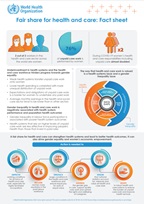Achieving gender equality and empowering women in the health and care workforce
The health and care sector is a major source of employment globally, particularly for women, who in 2020, made up 67.2% of workers in the health and care sector worldwide. The relative attractiveness of this sector to women in paid employment offers clear opportunities to drive women’s economic empowerment. Ensuring that women health and care workers are adequately valued, supported, protected and promoted are core to the attainment of the targets set in the World Health Organization Global Strategy on Human Resources for Health: Workforce 2030 and the Working for Health 2022-2030 Action Plan.
Fair share for health and care
For further information, partnership and engagement opportunities, please contact:
Michelle McIsaac, Economist, Health Workforce
World Health Organization, Avenue Appia 20
1211 Geneva 27 Switzerland
Email: workforce2030@who.int
Multimedia

Fair share for health and care fact sheet
Publications
The Fair Share report outlines how gender-equitable investments in health and care work can help fully recognize the value of health and care work, to...
The gender pay gap in the health and care sector a global analysis in the time of COVID-19
The health sector, with its high potential for decent jobs growth, and with 67% of wage employees being women, has a key role to play in women’s...
Working for Health 2022-2030 Action Plan
The Working for Health 2022-2030 Action Plan presents how WHO, Member States, and stakeholders can jointly support countries to optimize, build and strengthen...
Health labour market analysis guidebook
The health labour market analysis guidebook provides a comprehensive overview of the health labour market, offers guidance on how to analyse and understand...
Closing the leadership gap: gender equity and leadership in the global health and care workforce
*UPDATE: 2024 data. According to the National Health Workforce Accounts, women comprise 67.2 per cent of the health workforce globally.Based on data available...
The health and social sector, with its 234 million workers, is one of the biggest and fastest growing employers in the world, particularly of women. Women...
Delivered by women, led by men: A gender and equity analysis of the global health and social workforce...
The report, produced by the WHO Global Health Workforce Network’s Gender Equity Hub, co chaired by WHO, and Women in Global Health, is the latest...
High-Level Commission on Health Employment and Economic: Final report of the expert group
The United Nations Secretary-General, Ban Ki-Moon, established the High-Level Commission on Health Employment and Economic Growth in March 2016. Its task...
External publications
How economic implications of gender gaps in employment affect global health equity
Time for gender-transformative change in the health workforce
Violence against female health workers is tip of iceberg of gender power relations
Resolutions
- WHA75.17 – Human resources for health (Working for Health (2022-2030) Action Plan, Global health and care workers compact) (2022)
- WHA74.14 - Protecting, safeguarding and investing in the health and care workforce (2021)


/health-workforce-(hwf)/health-labour-market-and-partnerships-(hlm)/20240313-fsr-launch-short.tmb-549v.png?sfvrsn=56b042c4_1)